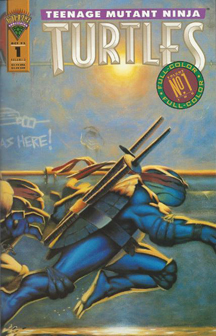In an editorial in Issue 50 of Mirage “Teenage Mutant Ninja Turtles” Volume 1, Kevin Eastman professed his happiness with reaching 50 issues, despite doing so more slowly than a major publisher would, and he outlined his intent to reach Issue 100 someday.
Eastman and Laird changed their minds midway through the popular and acclaimed “City at War,” though, deciding to ride the creative high point to a newly minted all-color Volume 2, which launched two months after Volume 1 ended with Issue 62.
Writer/artist Jim Lawson had done a wonderful job on “City at War,” and – like an employee whose boss says “You did a great job on that project, so as a reward, here’s an even bigger project” – he had those duties again on Volume 2, except this time Peter Laird would not be co-writing.

“Teenage Mutant Ninja Turtles” Volume 2 (1993-95)
13 issues
Writer: Jim Lawson
Pencils: Jim Lawson
Inks: Jason Temujin Minor
Colors: Jim Woodring, Mary Woodring
Also, Lawson didn’t have the benefit of a long gestation period (E&L had the luxury of mapping out “City at War” while other writers were putting out monthly issues). And although it would eventually run 13 issues, the same length as “City at War,” it was originally intended to go further. Lawson needed to be armed with long-ranging story ambitions.
Moving on
If it sounds like I’m making pre-emptive excuses for Lawson, well, I am — he had delivered some great stuff, and Volume 2 isn’t on that level. That’s not to say that Volume 2 is all bad. While the story seems less essential than “City at War,” Lawson gives us a nice sense – especially in the early issues — that we’re moving into a new chapter. Volume 2 is the equivalent of the first post-high-school season of a teen TV show; it’s like the decent Season 4 of “Buffy” coming on the heels of the outstanding Season 3.
Read consecutively, as in a trade paperback (although there is no TPB of Volume 2 yet, not even in the IDW reprint series), Volume 2 flows a lot better than it did during its initial publishing schedule, which included an eight-month delay (!) between Issues 9 and 10.
Of course, this is true of all serial comics, but a steady read-through is the only way to enjoy these Baxter Stockman (1-9) and Rescue of Raph from D.A.R.P.A. (10-13) arcs. They’re skippable if you only want the very best “TMNT” stories, but important to readers who want the full story, as they show the Turtles’ first steps beyond their “high school” years and beyond lives mostly defined by a family feud with the Foot Clan.
Separate ways
As Volume 2 begins, the Turtles are crammed in a basement apartment in Casey and April’s building where they can’t be too noisy lest they be found out by neighbors. So while Mike decides to stay there, Don opts to live on the farm (and Splinter – absent from the Volume 2 narrative – is in a cave nearby, no doubt meditating over the fact that he had to eat rats to survive in “City at War”), Leo scouts out a sewer lair (complete with basketball hoop!) for himself, and Raph selects a church clock tower to live in.
They’ve all chosen their own paths and are living apart for the first time. Meanwhile, Casey and April are settling into family life, raising baby Shadow.
As with the narrative, Lawson lets his art breathe so the colorists can do their thing. As such, there are fewer background details than in Lawson’s previous work. Many background walls are simply a solid yellow. We’re seeing Mirage learn how to do a color comic, and they do a respectable job, but their strength remains black-and-white. This color art is clean and simple.
The story doesn’t start in simple fashion, though: It launches with the incredibly wacked-out “Memories of the Future” (1), full of dream sequences. Some of it is solid character- or plot-based stuff: Casey worries that he’ll revert to his violent tendencies around Shadow, while April has flashbacks to the time when her boss, Baxter Stockman, tried to kill her in Volume 1, Issue 2.
Most of it is weird and inexplicable: The opening panel shows Splinter bloodied and beaten (dead?) at the hands of a Turtle; the ending finds Raph being experimented on by aliens, with a Triceraton nearby.
Back to Baxter
Issues 2-9 bring back Baxter, whose fate we did not learn at the end of the mouser crisis in Volume 1, Issue 2. He was a clichéd mad scientist back then, so Lawson ups the ante by making him REALLY crazy now. We find that Baxter is working for D.A.R.P.A. (Defense and Research Projects Administration); presumably the government caught him after the mouser scandal and recruited him rather than jailing him.
He kills a bunch of his military colleagues, and by the end of “Winds of Change” (2), he’s drawing dotted lines on his head marking where to extract his brain and put it in a killer robot, something he accomplishes in “Evolution” (3).
“Intruders” (4) and “Death Race” (5) find Don shooting the breeze over a cup of tea with Nobody, and Leo fighting a gigantic snapping turtle and a fish mutant similar to the ones we saw in Volume 1, Issue 28, although this one is concerned with protecting an egg, so presumably it’s a female and the race might not die out after all. This storyline would end up not going anywhere in Volume 2, probably because of the premature cancellation.
Robot Baxter’s story finally merges with our heroes’ in Issue 6, “Killer on the Loose” – yes, this first arc of Volume 2 is rather deliberately paced – when he attacks April’s car. In “Confrontations” (7) and “Face Off” (8), Robot Baxter has a rooftop showdown with the good guys.
Raph disappears in the melee, and for the first time, we get a callback to Issue 1 when we see Raph strapped to a table hooked up to a bunch of tubes. So while the story had been mostly action and trippy sci-fi up to this point, it delivers a solid cliffhanger to keep folks coming back.
A delay, then D.A.R.P.A.
After the Turtles dispatch Baxter in “Victory?” (9), there was the little matter of an eight-month delay (perhaps accompanied by Mirage Studios fretting over declining sales). Finally, Issues 10-13 gave Lawson a chance to button up the story of Raph’s kidnapping by D.A.R.P.A. before the book’s cancellation. Many fans assumed the title ended with Issue 9, so in a way, these last four issues were a bonus.
The D.A.R.P.A. arc is noteworthy for sending the Turtles to Nevada, thus marking the first time (other than oddball stories like Mark Bode’s) that they traveled away from New York and New England for an adventure. It’s also memorable for being pretty awful in several ways: Casey talks like Arnold Schwarzenegger after mind-controller Braunze convinces him he’s a top-notch special ops man.
Nobody dies in the attempted escape. A Triceraton communication device brings a group of vengeance-seeking Triceratons to Earth in a continuation from Volume 1, Issue 7.
But none of this works: Casey, potentially an intriguing character at this point, is reduced to a joke; Nobody’s death seems like a waste, as he had started to become a decent character; and while it’s cool in the abstract to see Triceratons again, they are the same single-minded warmongers we knew back in their first appearance, even though “Return to New York” Book 2 and the “Grunts” short had given them some depth.
As so often happens with final issues of canceled series (see also Marvel “Star Wars” 107, or the final TV episodes of “Angel” or “Dollhouse”), “The Battle” (13) is an exercise of tying loose plot threads into a neat bow. In fact, everyone’s memories of the events are erased by Braunze.
A low point, and a handoff
All told, the D.A.R.P.A. arc was a low note for Mirage to go out on as it handed off the reins to Erik Larsen’s Image Comics, which had already dipped into “TMNT” with some “Savage Dragon” crossovers. Image would deliver its first full-on “TMNT” comic, “Bodycount” No. 1 (originally “Casey Jones & Raphael,” which got truncated to one October 1994 issue from Mirage), to comic shops in March 1996 and it would launch “TMNT” Volume 3 in June ’96.
As it turned out, this wasn’t the end of Mirage’s “TMNT,” as Volume 4 and “Tales of the TMNT” Volume 2 combined to deliver more than 100 new issues of Turtle action in the Aughts. But in 1996, after the production (and probably financial) troubles of Volume 2, E&L wanted to take a break from the Turtles and let someone else play with them for a while.


